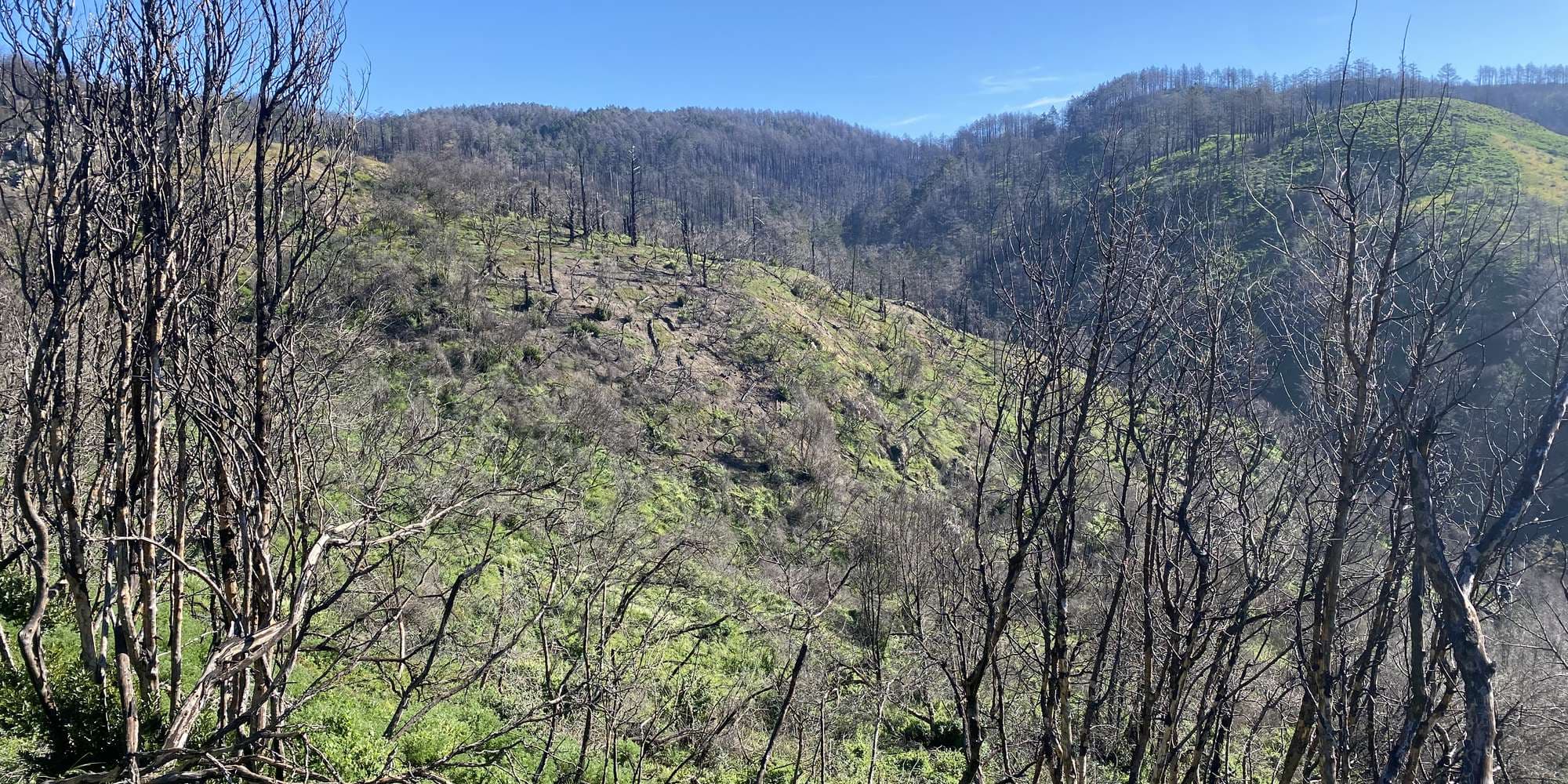2022
2023
2024
2025



2022
2023
2024
2025
Woodward Fire Photomonitoring Site 4
Managed by Point Reyes National Seashore Association
Since 2022
In California, US
PRS104
This chronolog combines 321 photos from 299 contributors. Learn more
About this site
An early burn site photo from December 9th, 2020.
Wildland fires are often named after a landmark near its origin point. The Woodward Fire was named after the Woodward Valley, seen from this photo monitoring point, and not far from where the fire originated. While much of the Woodward Fire burned with low or moderate heat, there were several tracts such as this that did burn severely and will take longer to recover.
When a fire burns with high heat, it can burn the soil as well as the overlying vegetation. Scorched soil may become hydrophobic, forming a crust that repels water, making it harder for new plants to root and more subject to erosion. Fires that burn with high heat don’t leave behind as much organic matter, and it will take longer for these areas to rebuild a nutrient rich soil that is ideal for new life.
Many factors lead to a fire’s heat intensity on any given day, and several of those factors are visible at this location. This area had not burned in many years, meaning it had a lot of woody fuels ready for the fire to consume. Fires like to climb uphill, and the steepness of the slopes in the Woodward Valley made it very susceptible to a hot, fast moving fire. This same steepness and density of the brush also made it hard to access for firefighters. Additionally gusty winds, common in Point Reyes, helped breathe oxygen into the fire and made it spread faster during its first few days.
Since the vast majority of the Woodward Fire burned at a low severity, it stands in stark contrast to many of the destructive fires that have occurred across California in the last decade. Less frequent burns due to many years of fire suppression, and hotter, drier, longer summers driven by climate change, means that this trend will likely continue. Hopefully watching how this tract of land recovers over the next several years will help us understand how these ecosystems might be able to bounce back.
About Point Reyes National Seashore Association
Located just north of San Francisco, the Point Reyes National Seashore spans 110 square miles of coastline, rocky headlands, expansive sandy beaches, open grasslands, brushy hillsides, and forested ridges. Point Reyes offers visitors over 1500 species of plants and animals to discover across a variety of habitats and designated wilderness areas. Home to several cultures over thousands of years, the Seashore also preserves a tapestry of stories and interactions between people and their natural surroundings.
On Monday, August 17, 2020, a lightning storm sparked a wildfire within Point Reyes National Seashore which was named the 4-5 Fire, north of the junction of Woodward Valley Trail and the Coast Trail. On Tuesday, August 18, a second lightening ignition was located nearby, originally named the 4-6 Fire. Aided by gusty winds, these fires soon combined to form the Woodward Fire, which quickly grew in size. Various resources from across the country and state were called in to help control the blaze. By Thursday, October 1, 2020, the Woodward Fire was 100% contained at 4,929 acres in size, but not declared officially out until Tuesday, January 12, 2021.
All told, park scientists and managers largely consider the Woodward Fire to be ecologically beneficial because it had a mix of burn severity. Periodic wildfires are a common feature of many California ecosystems, and many native plant communities are adapted to tolerating or even requiring occasional fire events for reproduction and regeneration. The vast majority of parklands within the fire’s footprint received a low or moderate burn, which can lead to healthy fuel reduction and improved habitat for many native species. Other tracts of land sustained a more severe burn, and these areas may take longer to recover from the event.
Your photo contributions will help park scientists track re-growth in the Woodward Fire zone and answer questions about plant and animal habitat recovery following the fire.
The Woodward Fire Recovery Monitoring Project is a joint program of the Point Reyes National Seashore Association and the National Park Service.
The Point Reyes National Seashore Association (PRNSA) was formed to help the National Park Service preserve and enhance the Point Reyes National Seashore’s natural, cultural and recreational resources. As the park’s primary nonprofit partner, we raise funds to support critical resource preservation projects and offer year-round environmental education programs that engage the public in accessing, enjoying and understanding Point Reyes National Seashore.
For nature-lovers
Explore chronologs
For organizations
Chronolog is a monitoring tool for parks, nature centers, wildlife organizations, schools, and museums worldwide. With over 100,000 contributors across 300 organizations, Chronolog is on a mission to engage communities with nature while recording important natural changes.
© Chronolog 2025 | Terms